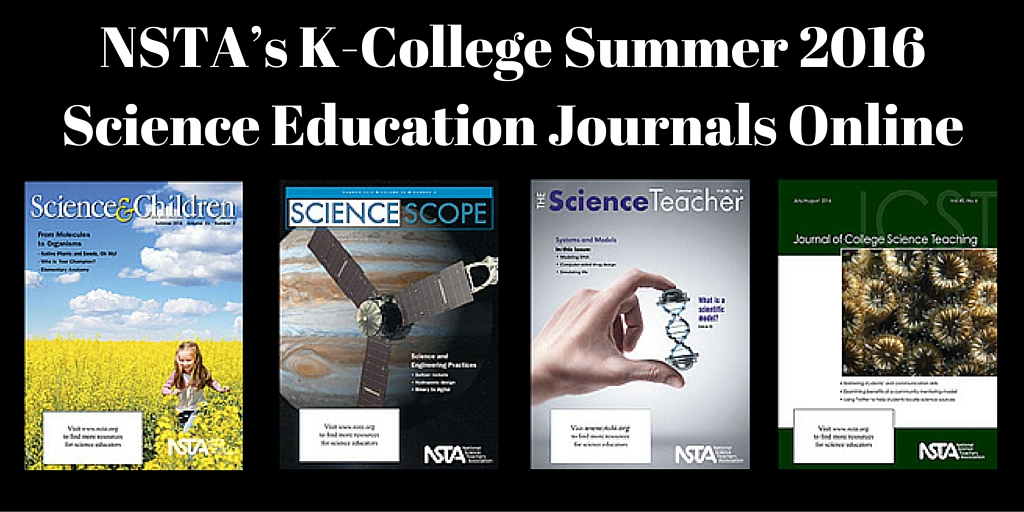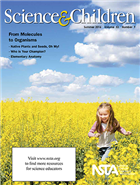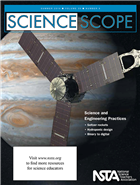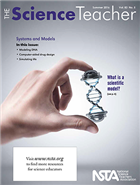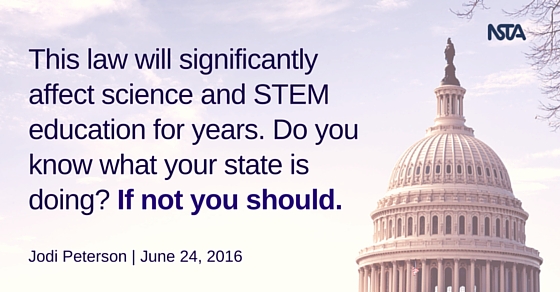NSTA’s K-College Summer 2016 Science Education Journals Online
By Korei Martin
Posted on 2016-07-01
Want to engage your students in learning about structure and processes from molecules to organisms? What about learning more about Juno’s mission to Jupiter? Are your high school students confused on what the word model means in relation to science? Are your college students interested in interdisciplinary problem based learning? The Summer K–College journals from the National Science Teachers Association (NSTA) have the answers you need. Written by science teachers for science teachers, these peer-reviewed journals are targeted to your teaching level and are packed with lesson plans, expert advice, and ideas for using whatever time/space you have available. Browse the Summer issues; they are online (see below), in members’ mailboxes, and ready to inspire teachers!
The Next Generation Science Standards call for students to learn structure and processes, from molecules to organisms. In this issue of Science and Children, students discover how plant and animal structures can solve a problem, how plant parts work together and function—and even get an introduction to parts of the human body.
Featured articles (please note, only those marked “free” are available to nonmembers without a fee):
- Elementary Anatomy
- Learning About Plants With STEAM
- Who Is Your Champion?
- Stalk It Up to Integrated Learning
- Making the Transition to Three-Dimensional Teaching
- Free – Native Plants and Seeds, Oh My!
- Free – Editor’s Note: From Molecules to Organisms
- Full Table of Contents
Juno’s mission to Jupiter is one of the latest aerospace engineering marvels that is expanding our understanding of our solar system and the universe. Help launch the next wave of engineers that will build on Juno’s success by sharing the activities found in this issue with your students.
Featured articles (please note, only those marked “free” are available to nonmembers without a fee):
- Bone Tissue Engineering: An Interactive Engineering Design Module
- Engineering Seltzer Rockets
- Engineering Technology for the Digital World
- WISEngineering Hydroponics: A Technology-Enhanced, Life Science Engineering Design Unit
- Tired and True: Falling in Style
- Free – Editor’s Roundtable: Saying Goodbye: An Editor’s “Footprint” on Science Scope
- Free – Evaluating the Egg Drop: Using the EQuIp Rubric to Ensure Activities Meet the Next Generation Science Standards
- Full Table of Contents
Fashion models, role models, economic models, model organisms, 3D models, climate models, model airplanes, model cars, and car models. We use the term model in so many ways in everyday speech, it’s no wonder students are often confused when we talk about models in science class. In every scientific discipline, the most important overall goal is to develop understanding of how the natural world works through the construction of scientific models, which are conceptual models. Our classes should be focused on engaging students in this central science and engineering practice.
Featured articles (please note, only those marked “free” are available to nonmembers without a fee):
- Computer-Aided Drug Design
- Connecting the Visible World With the Invisible
- Crafting a Masterpiece
- Explaining Ramps With Models
- Simulating Life
- Free – Editor’s Corner: What Is a Scientific Model?
- Free – Modeling DNA
- Full Table of Contents
Journal of College Science Teaching 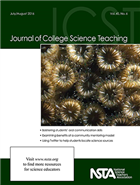
Read about an interdisciplinary, problem-based learning course titled Writing Science for the Public that was designed to teach students how to effectively communicate science to the public. Learn how a model for an optional, research-based course was
used to bridge two traditionally separate, introductory science courses. And don’t miss this issue’s Two-Year Community column, which features an article on a project that provided scholarships and an embedded social worker model to increase retention, graduation, and employment rates for at-risk students in a STEM field.
Featured articles (please note, only those marked “free” are available to nonmembers without a fee):
- What Can Students Learn About Lab Safety From Mr. Bean?
- Research and Teaching: Using Twitter in a Nonscience Major Science Class Increases Journal of College Science Teaching
- Learning Experiences of University Biology Faculty: A Qualitative Pilot Study
- Research and Teaching: The Explorations Program: Benefits of Single-Session, Research-Focused Classes for Students and Postdoctoral Instructors
- Live From Boone Lake: Interdisciplinary Problem-Based Learning Meets Public Science Writing
- Assessing Climate Literacy Content in Higher Education Science Courses: Distribution, Challenges, and Needs
- Free – A Community Mentoring Model for STEM Undergraduate Research Experiences
- Full Table of Contents
Get these journals in your mailbox as well as your inbox—become an NSTA member!
The mission of NSTA is to promote excellence and innovation in science teaching and learning for all.
Follow NSTA
Flow of Matter and Energy in Ecosystems (Student Edition)
What goes into a small science starter kit?
By Peggy Ashbrook
Posted on 2016-06-30
A colleague asked me, “If you were going to provide a small starter set of science materials for family child care providers, what would you buy?” This group will be participating in some science education professional development. Most of these early childhood educators speak English as a second language but they might not read it very well. The children in their care vary in age from infants to school age children.
 I suggested 5 plastic hand held magnifiers, 5 pipettes or droppers, a water color paint set with just 3-4 colors, a few extra brushes, and a book to look at, read and discuss with children of different ages—What Is A Scientist? By Barbara Lehn with photos by Carol Krauss (1998 Lerner Group).
I suggested 5 plastic hand held magnifiers, 5 pipettes or droppers, a water color paint set with just 3-4 colors, a few extra brushes, and a book to look at, read and discuss with children of different ages—What Is A Scientist? By Barbara Lehn with photos by Carol Krauss (1998 Lerner Group).
 I chose the magnifiers because they are durable and help us see details of structures such as flowers and rocks. The droppers are also a tool, good for making drops of water to play with, and help children practice their pincer grip. Children can use the paint set to make pictures of what they observe, and to explore color mixing. The book What Is A Scientist? has photos of a variety of children engaged in the practices of science. They are doing interesting work in activities that children can do in their home or at their child care provider’s home. There is text—one page with a small amount and one page with more explanation—and it ends with “Scientists have fun.”
I chose the magnifiers because they are durable and help us see details of structures such as flowers and rocks. The droppers are also a tool, good for making drops of water to play with, and help children practice their pincer grip. Children can use the paint set to make pictures of what they observe, and to explore color mixing. The book What Is A Scientist? has photos of a variety of children engaged in the practices of science. They are doing interesting work in activities that children can do in their home or at their child care provider’s home. There is text—one page with a small amount and one page with more explanation—and it ends with “Scientists have fun.”
What materials would you recommend be part of a starter kit for engaging young children in science learning?
(May I suggest a set of blocks too?)
A colleague asked me, “If you were going to provide a small starter set of science materials for family child care providers, what would you buy?” This group will be participating in some science education professional development. Most of these early childhood educators speak English as a second language but they might not read it very well. The children in their care vary in age from infants to school age children.
Teaching more than one subject
By Mary Bigelow
Posted on 2016-06-30
 I’m a recent graduate. A school district where I would really like to teach has an opening for a secondary science teacher. But when I read the job description, the position requires teaching five classes of two different subjects (general biology and an environmental science elective). During student teaching, I just taught biology. Is it common for teachers to have more than one subject? How can I do this? I felt overwhelmed with just one! –L., California
I’m a recent graduate. A school district where I would really like to teach has an opening for a secondary science teacher. But when I read the job description, the position requires teaching five classes of two different subjects (general biology and an environmental science elective). During student teaching, I just taught biology. Is it common for teachers to have more than one subject? How can I do this? I felt overwhelmed with just one! –L., California
I’ve worked with many schools where teaching more than one subject is the rule rather than the exception. In smaller 7-12 buildings, there may be only one or two science teachers for all of the classes! Even in larger schools, it’s very common for teachers to have multiple preparations, based on student enrollment in required courses, the scope of electives offered, the teacher’s area(s) of certification, and sometimes his or her seniority.
In my own experience, I taught both life and physical science for several years, and at the high school I once had three different preparations, plus mentoring independent study. Even at the university level I taught two to three different courses each semester. I understand your concern.
And don’t forget elementary teachers who routinely plan four or more subjects (reading/language arts, math, science, and social studies) every day!
As you learned in student teaching, the obvious advantage of teaching one subject is you can concentrate all of your time and effort on a single preparation. You’ll have one lesson plan, one system of assessments, and one set of lab activities. The disadvantage is the time you’ll need to evaluate student work with the same due date. When I taught six classes of life science, I often spent Saturdays at school grading 150 projects or lab notebooks, in addition to the paperwork I would take home or review electronically.
A disadvantage to teaching more than one subject is the preparation time. You’ll need separate unit plans, lessons, and lab activities for each. But an advantage is that with careful planning you can schedule separate dates for tests, projects, lab investigations, student presentations, and notebook reviews, spreading out the evaluation work and preserving some of your sanity!
I actually enjoyed teaching more than one subject. When I taught six sections of life science, I found that by the end of the day, it was hard to remember what we discussed in each class. I had to have the energy to make the last period as engaging as the first, and I had to remember that even if I had heard a question five times already, to a student in the last class it was a new idea. I found that teaching more than one subject was intellectually challenging, and I appreciated the opportunity to update my own content and skills in more than one area.
There are many strategies you can use to keep yourself (and the students) organized. Try not to set up and conduct two different labs on the same day. Divide your bulletin boards and shelves into two separate areas so that students know where things are and where to turn in their assignments. I used a different logo for each course, putting it in the upper right corner of handouts, quizzes, or other documents. I used separate folders (with the same logo) on my laptop and separate three-ring binders for each course to organize lesson plans and other resources. I also had a tote bag for each course to keep materials from getting mixed up.
It also helps if the subjects are in consecutive periods (e.g., bio in the morning, the other class in the afternoon), so that you can keep lab materials set up—a question to ask during the interview. Otherwise, you will have to secure the materials when the other class comes in.
As a beginning teacher, your first year or two will be overwhelming, no matter how many subjects you teach! But as many of our veteran colleagues will attest, after a year or two it gets becomes more manageable. I’m hoping you would have a mentor or supportive administrator to help you, and NSTA’s e-mail lists, discussion forums, and publications can provide support and suggestions.
 I’m a recent graduate. A school district where I would really like to teach has an opening for a secondary science teacher. But when I read the job description, the position requires teaching five classes of two different subjects (general biology and an environmental science elective). During student teaching, I just taught biology. Is it common for teachers to have more than one subject? How can I do this? I felt overwhelmed with just one!
I’m a recent graduate. A school district where I would really like to teach has an opening for a secondary science teacher. But when I read the job description, the position requires teaching five classes of two different subjects (general biology and an environmental science elective). During student teaching, I just taught biology. Is it common for teachers to have more than one subject? How can I do this? I felt overwhelmed with just one!
Bringing STEM to the Elementary Classroom
By Carole Hayward
Posted on 2016-06-29
National initiatives, such as A Framework for K-12 Science Education and the Next Generation Science Standards (NGSS), call for an increase in both the quality and quantity of engineering content. With the addition of engineering to science classrooms, where math and technology have traditionally been included, we now have STEM (science, technology, engineering, and mathematics).
Evidence shows that 21st-century workers require skills that many graduates do not acquire through formal education. Students needs more experiences that provide in-depth knowledge of the STEM disciplines and apply to problem solving.
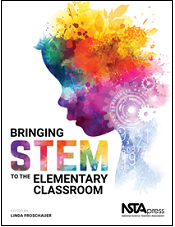 In Bringing STEM to the Elementary Classroom, edited by Linda Froschauer, the authors of each chapter are initiating STEM strategies as they work toward also meeting the requirements of the NGSS. The book’s 36 lessons, organized by grade-level bands, provide the important elements needed for an effective STEM experience.
In Bringing STEM to the Elementary Classroom, edited by Linda Froschauer, the authors of each chapter are initiating STEM strategies as they work toward also meeting the requirements of the NGSS. The book’s 36 lessons, organized by grade-level bands, provide the important elements needed for an effective STEM experience.
Linda Froschauer explains that “STEM should involve problem-solving skills, serve all students equally well, encourage learning across disciplines, promote student inquiry, engage students in real-world problem solving, and expose students to STEM careers. Meeting these needs requires a continuum of learning with a focus on elements that will develop the skills and content over time and through many experiences. Whether you are just beginning to delve into STEM experiences or you have been building STEM lessons and are now seeking new ideas, this book will provide you with new, interesting, and productive strategies.”
The variety of strategies and topics used throughout the book include:
- Lessons using the BSCS 5Es
- Tested, reliable, and even some original design processes
- Pre-assessment strategies and evaluation rubrics
- Data sheets and learning tools that are readily available for immediate printing and use
- Use of technologies—from digital notebooks to three-dimensional printing
- Challenges that relate to real-world problems, such as filtering water, recycling waste, and collecting water
- Design constructions that solve problems, such as a soundproof wall, wind turbines, moving objects, solar ovens, structures to withstand harsh weather, and protections for living things
- Experiences to develop an understanding of technology
The first two chapters provide strategies that you can use at many grade levels. Chapter 1 introduces you to the process of designing STEM lessons, and Chapter 2 will assist you in identifying the misconceptions of students who are new to STEM.
Check out the sample chapter: “A House for Chase the Dog.” This book is also available as an e-book.
Follow NSTA
National initiatives, such as A Framework for K-12 Science Education and the Next Generation Science Standards (NGSS), call for an increase in both the quality and quantity of engineering content. With the addition of engineering to science classrooms, where math and technology have traditionally been included, we now have STEM (science, technology, engineering, and mathematics).
Get Involved in Your State’s ESSA Planning
By Jodi Peterson
Posted on 2016-06-23
Many states are moving ahead rapidly in planning for implementation of the Every Student Succeeds Act (ESSA). ESSA requires that state and district stakeholders—including teachers—be given opportunities to shape how the new law will be implemented. This law will significantly affect science and STEM education for years. Do you know what your state is doing? If not you should.
State leaders want to hear from teachers, and this is a perfect chance for your voice to be heard.
To find out what your state is doing to get ready for ESSA (and how teachers can get involved) begin by searching your state’s department of education website for its ESSA resources and activities. Many states are now holding listening meetings, convening task forces, and reaching out to stakeholders for input. If you can’t find the information online then talk to district or state leaders to find out what opportunities are available and how you can get involved.
Here’s a list of what some states are doing. If you don’t see your state listed here please take a minute and visit your state’s department of education. Questions? Shoot me an email at jpeterson@nsta.org. Good luck—let’s make sure that the unique voices of science and STEM teachers are heard loud and clear as this law becomes reality.
State Implementation, ESSA (June 23, 2016)
- North Carolina has an ESSA timeline implementation guide and resources.
- Wisconsin is hosting a series of listening tours this summer.
- Florida is soliciting feedback on its state plan for ESSA through July 22.
- Washington State and Nevada have formed ESSA teams and work groups that will be meeting with stakeholders throughout the state.
- California is hosting a series of regional stakeholder meetings to provide an overview of the new law, provide an update on the development of the ESSA State Plan and to consult with stakeholders on what should be included in the State Plan.
- Iowa has created ESSA webinars and FAQs.
- Michigan is issuing ESSA e-mail updates.
- Montana created an ESSA Workplan Group to guide the state’s ESSA implementation.
- New Jersey is seeking input from state groups and teachers to develop their state plan.
- Illinois held an listening tour during the spring of 2016 to give stakeholders from across the state an opportunity to provide feedback on ESSA implementation.
- Pennsylvania has convened working groups and has a strategic plan to move forward in implementing ESSA.
- Colorado’s ESSA listening tour is over, but state officials are still accepting feedback.
- Wisconsin has plans for five listening tours (two virtual) this summer.
Also, here are the links to what these states are doing with ESSA:
Finally, a new video interview series from the Education Commission of the States and the Building State Capacity and Productivity Center (BSCP) features interviews with the Chief State School Officer from Pennsylvania, North Carolina, Arkansas, Oklahoma and Iowa about the opportunities and challenges that exist for states regarding the implementation of ESSA and about the potential for collaboration as states develop their individual plans.
Jodi Peterson is Assistant Executive Director of Legislative Affairs for the National Science Teachers Association (NSTA) and Chair of the STEM Education Coalition. e-mail Peterson at jpeterson@nsta.org; follow her on Twitter at @stemedadvocate.
Follow NSTA
Science Scope: Don't Teach Tweens Science Without It!
By Guest Blogger
Posted on 2016-06-23
NSTA recognizes the key role that middle school science educators play through Science Scope, a peer-reviewed journal published nine times during the year. If you are like me, you eagerly anticipate the arrival of the latest Science Scope issue. Its presence in your mailbox is like a breath of fresh air, harkening you to try new activities and teaching strategies in your classroom. My personal relationship with Science Scope has changed over the years; I am a long-time reader and have also written several features. Today, I am embarking on a new journey with Science Scope—that of its field editor. Science Scope is OUR personal journal—a journal dedicated to those of us who understand the challenges of teaching the tweens. The strength of Science Scope lies in the quality and diversity of articles submitted by teachers like you—teachers who know how to employ thoughtful and purposeful methods for directing the effervescent energy of a middle school child into meaningful learning about the world around them.
Middle school educators are compassionate and caring people who never fail to volunteer their time or energy. As such, I encourage you to consider sharing a teaching or classroom management idea with other middle school science educators by writing an article for Science Scope. I know many of you are thinking “I could never write an article,” but I’m here to tell you that “Yes, you CAN!” It truly takes a team to produce the articles that you see in Science Scope; reviewers, editors, and NSTA’s amazing art department will help to take your raw idea and turn it into the polished product you see when you open the pages of Science Scope. You do not have to a gifted writer to be published in Science Scope, but you do have to be passionate about your craft and have a desire to share your ideas with others—characteristics that all middle school science teachers possess. If you are truly fearful of your ability to convey your ideas, try connecting with a language arts teacher in your building; a glance through Science Scope will reveal frequent co-authored articles.
If you are still unsure about writing a full-fledged article, I encourage you to volunteer to review for Science Scope. In doing so, you will see a variety of submitted manuscripts and will quickly comprehend how the germ of a great idea can be fleshed out into a magnificent piece. This metamorphosis is impossible without the contributions of reviewers; people such as yourself who understand how classroom management, safety, instruction, and assessment interplay to optimize leaning for our students. The time commitment for reviewing is minimal; you can expect to review six or eight manuscripts over the course of the year. In doing so, you will be playing an instrumental role in shaping future issues of Science Scope as you assist writers by providing recommendations for improvement. The process itself is known as a double-blind peer review in which the reviewer does not know the name of the author and the author does not know the name of the reviewer. This allows you to provide open and honest feedback via a forum that ultimately increases the quality of the articles you read. In addition, I promise that reviewing for Science Scope will result in professional growth and that you will enjoy the heightened involvement with NSTA (if you are interested in perusing the Manuscript Review Form).
As the school year ends and you relax by the pool, do some gardening, or go camping, I encourage you to consider how you can increase your personal relationship with Science Scope. Jot down some ideas you have for sharing with others and check the Call for Papers to see if any of your ideas match one of the upcoming themes. Do not feel that you have to write for a theme, however. ALL articles related to the teaching of middle school science—no matter what the content—are welcome! Consider, too, the possibility of writing for an established column. The Tried and True column is a perfect fit if you have a unique or updated twist on an established idea, the Toolkit column addresses teaching, classroom management, and assessment strategies, and Science on a Shoestring allows you to provide tips on how to create equipment or models that all budgets can afford.
 Hopefully, I have piqued your interest about becoming a member of the Science Scope community. Please contact me if you would like to review for OUR journal or if you have questions about the manuscript submission process. I look forward to hearing from you soon!
Hopefully, I have piqued your interest about becoming a member of the Science Scope community. Please contact me if you would like to review for OUR journal or if you have questions about the manuscript submission process. I look forward to hearing from you soon!
Patty McGinnis teaches at Arcola Intermediate School in Eagleville, PA. She is the field editor for Science Scope. She can be reached at pattymcginnis1@gmail.com.
Join NSTA today and receive Science Scope, the peer-reviewed journal just for middle school teachers; connect on the middle level science teaching list (members can sign up on the list server); or consider joining your peers for Meet Me in the Middle Day (MMITM) at the National Conference on Science Education in Los Angeles in the spring of 2017.
The mission of NSTA is to promote excellence and innovation in science teaching and learning for all.
Future NSTA Conferences
NGSS Workshops
- Discover the NGSS, San Diego, June 29–30
- NGSS Summer Institute, Reno, July 15
- NGSS Summer Institute, Detroit, August 8
- Discover the NGSS, Fall 2016 & Spring 2017
2016 STEM Forum & Expo, hosted by NSTA
2016 Area Conferences
2017 Na
tional Conference
Follow NSTA
DIY Your Science PD
By Mary Bigelow
Posted on 2016-06-20
 As a K-12 science department chair, I’m looking for professional development (PD) opportunities for our teachers. It’s hard to find speakers and programs for a small group. We have a very small budget, so traveling for conferences is not an option, either. Are you familiar with other options? —K., Minnesota
As a K-12 science department chair, I’m looking for professional development (PD) opportunities for our teachers. It’s hard to find speakers and programs for a small group. We have a very small budget, so traveling for conferences is not an option, either. Are you familiar with other options? —K., Minnesota
Continuing education is an important part of any job or profession. It is impossible as undergraduates to learn everything we need to know as teachers, especially about content or strategies that didn’t exist at that time or technology that was yet to be invented.
All teachers, including science teachers, have two fields that require continuing education—teaching practices and subject-area content. In my school district, it was easy for us to plan PD in teaching practices. Topics such as cooperative learning, assessment, classroom management, technology applications, curriculum design, questioning strategies, and reading/writing applied to virtually all of the subject areas. Teachers from different subjects could be part of the same workshops. We often used our own staff as facilitators for these sessions to capitalize on their experience and expertise.
But content was another issue, especially for science teachers.
It was difficult (and costly) to find facilitators to provide workshops or seminars on relevant content (as well as on national and/or state standards, safety updates, and cutting-edge lab technology) for the 8.5 secondary science teachers in our district. So once a year we science teachers (including biology, chemistry, earth science, and physics) combined with other schools for the generic “large group in an auditorium with a guest speaker.” These sessions were often redundant or irrelevant, and research has shown these one-off presentations, lacking context or follow-up, can be ineffective.
Add to the mix the fact that many districts are in a financial bind. When making cuts to programs, facilities, and staff, PD often goes on the chopping block as well. For both reasons (effectiveness and finances), many schools provide an option for and encourage self-directed PD, especially for veteran teachers. Although sometimes referred to as “do-it-yourself,” I’ve found this form of PD to be more collegial than traditional “sit-and-git” events.
In my district, teachers (or groups of teachers) worked with administrators to set learning goals focused on district priorities and personal needs, design a learning strategy, identify relevant resources, document their activities, describe how they will apply the new knowledge or skills, and submit a final report/reflection. In return, they received PD hours and were excused from two in-service days during the school year if they used the summer or their own time for the PD project.
There are many activities that could be part of DIY PD: Local mini-conferences, EdCamps, Professional Learning Networks (PLNs), online courses and web seminars offered by higher education and other organizations, action research, social media, book study groups, peer coaching, mentoring programs, onsite visits and tours, and independent study.
From your leadership perspective as a department chair, the learning experience of planning, administering, and evaluating a DIY program would be another form of professional development. It might be helpful to first study the options and pilot the program with a cross-section of interested teachers.
It would be easy for science teachers to design PD opportunities using the resources of NSTA’s Learning Center: the NSTA journals, e-mail lists, discussion forums, Science Objects, and web seminars.
A project such as this requires work on the part of the teachers, more so than sitting through a few presentations each year. It also requires a level of trust and professionalism between administrators and teachers. My own experiences with DIY PD (which included action research, peer coaching, mentoring new teachers, and independent study) were satisfying, relevant, and helped me become a better teacher.
Update: You might also be interested in events such as NSTA’s Virtual conferences. No travel required!
 As a K-12 science department chair, I’m looking for professional development (PD) opportunities for our teachers. It’s hard to find speakers and programs for a small group. We have a very small budget, so traveling for conferences is not an option, either. Are you familiar with other options? —K., Minnesota
As a K-12 science department chair, I’m looking for professional development (PD) opportunities for our teachers. It’s hard to find speakers and programs for a small group. We have a very small budget, so traveling for conferences is not an option, either. Are you familiar with other options? —K., Minnesota
Attend a conference, virtually
By Peggy Ashbrook
Posted on 2016-06-18
I remember the first time I attended a professional association conference when I was a child care provider beginning my career and was thrilled to be among so many educators who were passionate about improving themselves professionally. If you can’t attend a conference in person, a virtual conference may meet some of your needs for professional development.
 Join me next week on Wednesday, June 29, 2016 in my happy space–talking with other early childhood educators about science education at the virtual conference, “Engaging Students in Science: PreK-6.” I will be presenting one of two sessions, along with Christine Royce, Professor in and Department Chairperson for the Teacher Education Department and co-director for the MAT in STEM education program at Shippensburg University. She is the co-author of the NSTA Press Book, Teaching Science Through Trade Books, which is related to one of her more familiar roles as the co-author for the ”Teaching Through Trade Books Column” in Science and Children. This National Science Teachers Association virtual conference will be archived for registrants.
Join me next week on Wednesday, June 29, 2016 in my happy space–talking with other early childhood educators about science education at the virtual conference, “Engaging Students in Science: PreK-6.” I will be presenting one of two sessions, along with Christine Royce, Professor in and Department Chairperson for the Teacher Education Department and co-director for the MAT in STEM education program at Shippensburg University. She is the co-author of the NSTA Press Book, Teaching Science Through Trade Books, which is related to one of her more familiar roles as the co-author for the ”Teaching Through Trade Books Column” in Science and Children. This National Science Teachers Association virtual conference will be archived for registrants.

 I have seen how engaging in science investigations motivates students to develop and use their early literacy and math skills as they learn about the nature of science and specific science content. In the first part of my session, we will take a quick look at the research that calls for teaching our youngest learners to explore scientific ideas and then examine how young children use science and engineering practices in common activities in early
I have seen how engaging in science investigations motivates students to develop and use their early literacy and math skills as they learn about the nature of science and specific science content. In the first part of my session, we will take a quick look at the research that calls for teaching our youngest learners to explore scientific ideas and then examine how young children use science and engineering practices in common activities in early  childhood PreK-2 programs. In the second part, we will use photos (and materials if we have them at hand) to engage in one activity that can be part of an on-going inquiry into properties of water. Discussion will support how to extend children’s thinking from a simple “sink or float” activity to an on-going investigation.
childhood PreK-2 programs. In the second part, we will use photos (and materials if we have them at hand) to engage in one activity that can be part of an on-going inquiry into properties of water. Discussion will support how to extend children’s thinking from a simple “sink or float” activity to an on-going investigation.
Hope to see you on Wednesday, June 29, 2016 at 10 a.m. – 1 p.m. ET
9 a.m. – 12 p.m. CT
8 a.m. – 11 a.m. MT
7 a.m. – 10 a.m. PT
Member price: (Includes 1 e-book) $63
Nonmember price: (Includes 1 e-book) $79
Attendance/Participation Certificate: $9.95
(NSTA Press e-books: Science Learning in the Early Years or Teaching Science Through Trade Books)
 The free and open to all NSTA Learning Center early childhood and elementary science forums are other virtual communities for finding resources and discussion to support your science teaching. Search for resources and discussions and voice your experience.
The free and open to all NSTA Learning Center early childhood and elementary science forums are other virtual communities for finding resources and discussion to support your science teaching. Search for resources and discussions and voice your experience.
I remember the first time I attended a professional association conference when I was a child care provider beginning my career and was thrilled to be among so many educators who were passionate about improving themselves professionally. If you can’t attend a conference in person, a virtual conference may meet some of your needs for professional development.



